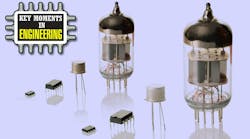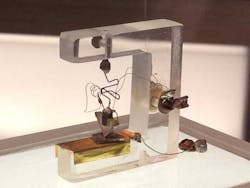This article is part of the Series Library: Key Moments in Engineering History.
What you’ll learn:
- The history of the transistor and similar types.
- How transistors made an impact on the world.
- How grudges eventually subside.
Transistors are simple electronic devices that boost or switch electrical signals and power. They’re part of the building blocks that make up modern electronics and are considered one of the 20th century’s greatest inventions. The transistor is today’s “Engineering Week Key Moments.”
Their history can be traced back to 1907 with the development of the thermionic triode, a device that enabled amplified radio technology and long-distance telecommunications. While triodes were remarkable for their applications during those early years, they were also fragile and consumed more power than they delivered. It wasn’t until 1947 that the first genuine transistors were developed using germanium, which produced a signal with an output power greater than the input.
In the early days of telephony, vacuum tubes served to amplify signals on telephone lines as they were transferred across the country from one switch box to another. Voice clarity degraded over long distances unless there were amplifiers to boost them along, but these were highly unreliable, prone to heat degradation, and dirty when it came to signals.
Move Over Tubes, Make Way for Semiconductors
During the 1930s, Bell Labs’ director of research, Mervin Kelly, realized a change was needed, something more efficient than tubes. He set his sights on a strange class of materials: semiconductors.
The year was 1947, WWII was over, and the U.S. was ripe for innovations within the electronics industry that was still dominated by vacuum-tube technology. But that was about to change. Kelly, with thoughts of semiconductor advances in his head, put together a team of engineers to develop a solid-state switch that would end the reliance on tubes.
To help him accomplish that goal, Kelly tapped inventor and physicist William Shockley, who shared Kelly’s vision and saw the potential of what semiconductors could accomplish as research lead. But Shockley needed a team to move that vision to fruition and drafted a pair of Bell Labs engineers, John Bardeen and Walter Brattain, to help him make that vision a reality.
During their time at Bell Labs, Bardeen and Brattain formed a great partnership, with John taking on the role of “ideas man” due to his background in theoretical physics, while Walter, who could fix just about anything, designed and ran the experiments.
By 1947, the pair began experimenting with layering gold on germanium and found that when two gold point contacts were applied to a germanium crystal, it produced a signal with the output power greater than the input. This led the pair to design and produce the first point-contact resistor, which was made from strips of gold foil on a plastic triangle substrate and pressed down onto a slab of germanium (see figure).
Shockley’s Junction Transistor
Shockley immediately saw its potential and placed the lab into overdrive to expand their insight into semiconductors. He was also furious that he wasn’t involved in the breakthrough and set out to design his own device that could utilize that technology.
He spent most of his time held up in a hotel room in Chicago, where anger and creativity pushed him to produce the first schematic of a junction transistor in four weeks' time. It took another two years before his device was built, but it was more practical and rugged than the point-contact resistor.
As one might imagine, Shockley proposed that the first patent for the new device should be named after its inventor—after all, his transistor design was superior to that of Bardeen and Brattain. However, lawyers at Bell Labs advised against that, citing field-effect transistor (FET) patents from Canadian physicist Julius Edgar Lilienfeld, whose work with triodes formed the basis of his, and Bardeen’s and Brattain’s, experiments. The accomplishments of all three were acknowledged in 1953 when they were awarded the Nobel Prize for their research on semiconductors and their discovery of the transistor effect.
It's interesting to imagine that the electronic world of today was born out of a desire to hear people clearly over long-distance telephone lines, a problem that still plagues mobile devices in areas with little to no cell coverage.
The animosity between Shockley and Bardeen/Brattain would eventually subside over the years. They would meet again 25 years later, in 1972, in the same Bell lab where it all began, to commemorate the anniversary of the transistor, a device they didn’t know at the time would change the world.

